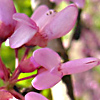Judas Tree (Red Bud, Love Tree) is a deciduous tree of the Mediterranean Maqui that blooms before the leaves sprout. The pink-crimson color of its flowers and their impressive amount on the tree justify the name Red Bud. The tree reaches a height of 3-10 meters. It has a single thick trunk or several branches. In places where it was damaged by animal browsing or fire it grows as a shrub. The bark of the trunk is cracked and scabrous with a gray color. The leaves are simple, cordate, with an entire margin. They alternate on the stem.
The flowers are bisexual and arranged in racemes. The tree blooms at two times. The main bloom occurs in March-May before the tree has sprouted. The tree also blooms in October-November, but then the flowers are almost invisible because of the dense leaves that conceal them. The racemes are located on branches of different ages as well as on the trunk. The presence of flowers on the trunk indicates the tropical origin of the tree.
The flowers are carried on a pedicel. They are 15-18 mm long and have 5 crimson sepals, and 5 pink-crimson petals. The shape of the corolla is characteristic of plants from the Caesalpiniaceae family. The central petal is shorter than the others and it is internal relative to the other petals. The two lateral petals cover part of the inner petal. The stamens of the 10 filaments are long and free. The ovary is superior and composed of one carpel. The flowers contain a large amount of nectar and attract bees as well as birds, especially sunbirds. The petals are also sweet and edible.
After pollination the ovary elongates and turns into a legumen. The legumen is green and gradually changes to brown upon ripening. The legumen is 7-15 cm long. It does not open and remains on the tree for a long time. Only strong winds cause the legumen to fall from the tree. The legumen contains numerous seeds that are approximately 3 mm long. They are flat, rounded and brown. When the legumens split open the seeds disperse and germinate with great ease. The tree’s reproduction is sexual.
The tree grows in Maquis in the mountainous regions of northern Israel and in an association with Quercus calliprinos and Pistacia palaestina. It also grows in an association with Quercus ithaburensis and Styrax officinalis. It prefers shady and humid habitats.
The tree is common in landscaping. It is a common ornamental tree in the north and center of Israel and decorates the garden during seasons when many other plants are still dormant.
Its distribution is Mediterranean and West Irano-Turanian.
This genus was in the family Caesalpinaceae which is considered now a sub-family of the Fabaceae
Written by Erga Aloni








